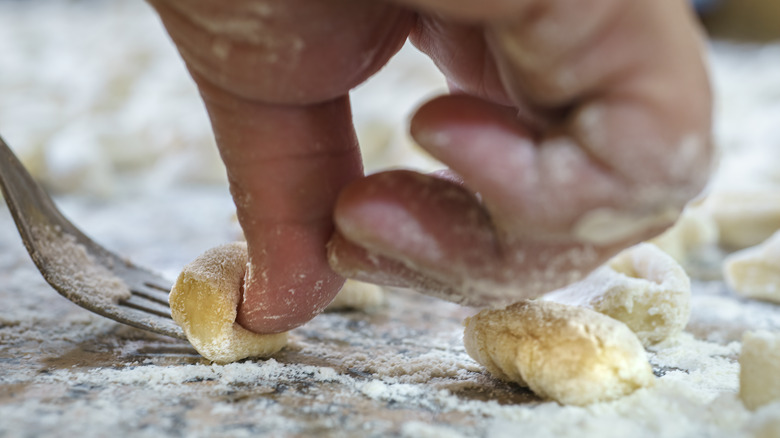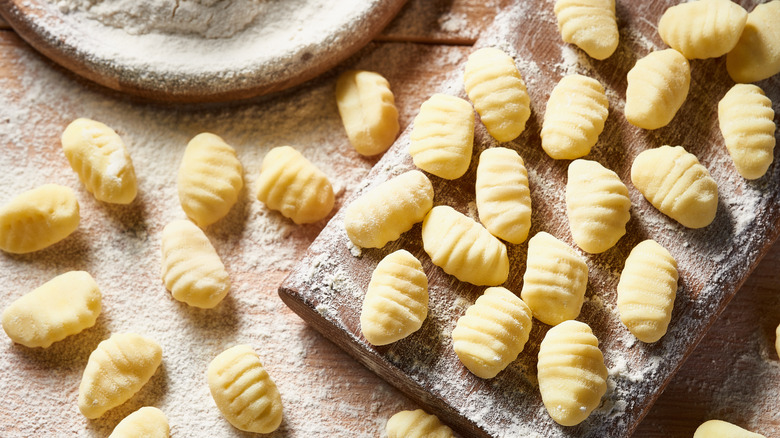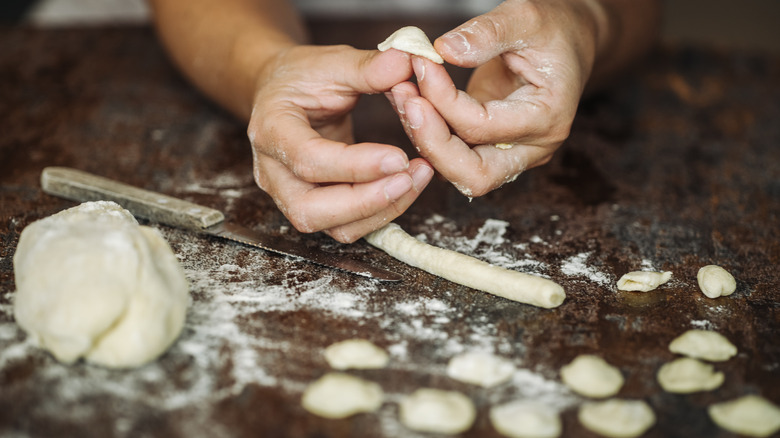The Fork Hack To Shape Gnocchi In Seconds
Gorgeous homemade gnocchi is within reach. Though the pillowy squares are delicious when portioned and boiled, adding the extra touch of delicate ridges will help catch any delicious brown butter or sauce on the plate. All you need to complete the extra step is a fork.
Although preparing the batter requires some culinary finesse, the shaping technique is easy to pick up. Since the starchy dough is moist and pliable, it needs only a gentle press against the tines to take shape. And the move works no matter if you stick with a traditional potato base, two-ingredient sweet potato gnocchi, or gnocchi made with an underrated vegetable like carrots.
Follow your recipe to create a plush dough and then create a series of long, slender rolls. Cut each strip into inch-long bites, and ready your fork. Rest each pillow of dough against the top flat part of a fork and roll it down to the end of the tines. As you draw it along the metal, it will curve into a rounded shape and imprint the grooves. In addition to looking nice, you'll find the resulting bumps elevate the meal to a restaurant-like quality.
Adding grooves to gnocchi and other pastas
Traditionally gnocchi and a few other noodles are rolled along a ridged paddle or board to get their shape. Though the wooden tool is inexpensive, usually between $5 and $15, it takes up precious room in small drawers. The tines of a fork make a great substitute since the tool is already on hand and offers the same grooves on a smaller canvas. Just like with the paddle, you'll want to practice and make quick, confident movements to churn out perfect bites.
If the fork method doesn't appeal, or you're eager to test out other designs, you can use other grooved kitchen items to dent the pillowy potato dough. Take advantage of the bumps on your grater and press and roll each piece down the back of the tool. For a more artful design, gently push gnocchi along the bumpy surface of a meat tenderizer or the holes of a colander.
Once you have a knack for the shape and nailed the sweet potato gnocchi recipe, you can apply the move to other pastas. Cavatelli, a semolina and water-based pasta, occasionally gets the fork treatment, as well. The tube-like seashell shape of the pasta already clings to the sauce but a press against a fork adds extra nooks and crannies for more grabbing power.
Other pasta-shaping tools in your kitchen
Set your fork aside and grab a butter knife. To make domed orecchiette, another eggless pasta, you can use cutlery to achieve the 'little ears' pasta. Press each portion of dough gently into a flat circle with the rounded edge of the knife, then add a curve by pushing the noodle against the top of your thumb like a hat.
A pizza cutter (or a sharp knife) can add flair to a sheet of pasta, too. After rolling out your dough, you can make diagonal and curving cuts to create artistic maltagliati. Don't let the name, which means 'badly cut,' get to you; the varying shapes make for the perfect finishing touch in soups and take the pressure off. If you have a fluted cutter, you can cut the sheet into squares and pinch opposite edges together to meet at the center and create bowtie-shaped farfalle.
Home cooks can also embrace a rustic shape and roll noodles by hand. Tuscan pici, made for tomato and wine-rich sauces, is a great challenge for kids and adults building their pasta skills. Thinly rolled dough gets cut into strips, and each strip is hand-rolled into thick, spaghetti-like strands ready to get put to use in a satisfying meal.



